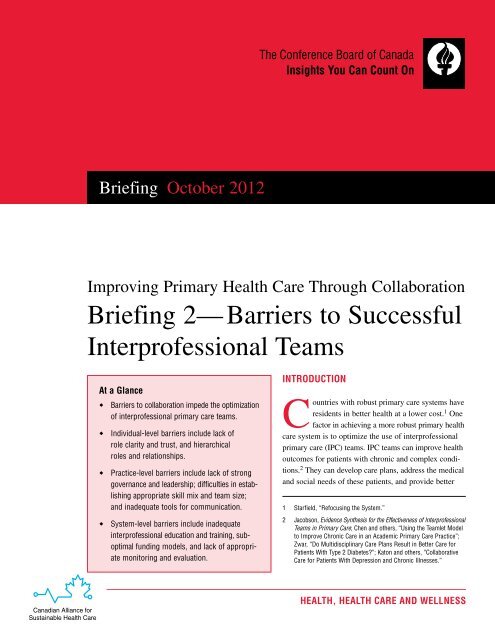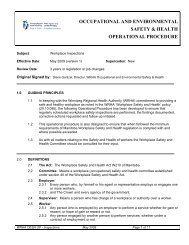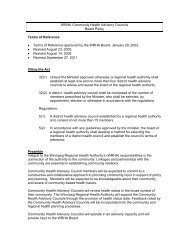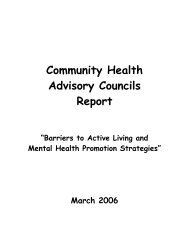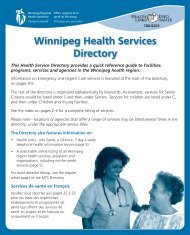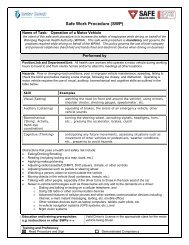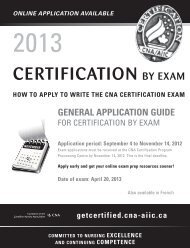Improving Primary Health Care Through Collaboration: Briefing 2 ...
Improving Primary Health Care Through Collaboration: Briefing 2 ...
Improving Primary Health Care Through Collaboration: Briefing 2 ...
- No tags were found...
You also want an ePaper? Increase the reach of your titles
YUMPU automatically turns print PDFs into web optimized ePapers that Google loves.
<strong>Briefing</strong> October 2012<strong>Improving</strong> <strong>Primary</strong> <strong>Health</strong> <strong>Care</strong> <strong>Through</strong> <strong>Collaboration</strong><strong>Briefing</strong> 2— Barriers to SuccessfulInterprofessional TeamsAt a GlanceBarriers to collaboration impede the optimizationof interprofessional primary care teams.Individual-level barriers include lack ofrole clarity and trust, and hierarchicalroles and relationships.Practice-level barriers include lack of stronggovernance and leadership; difficulties in establishingappropriate skill mix and team size;and inadequate tools for communication.System-level barriers include inadequateinterprofessional education and training, suboptimalfunding models, and lack of appropriatemonitoring and evaluation.IntroductionCountries with robust primary care systems haveresidents in better health at a lower cost. 1 Onefactor in achieving a more robust primary healthcare system is to optimize the use of interprofessionalprimary care (IPC) teams. IPC teams can improve healthoutcomes for patients with chronic and complex conditions.2 They can develop care plans, address the medicaland social needs of these patients, and provide better1 Starfield, “Refocusing the System.”2 Jacobson, Evidence Synthesis for the Effectiveness of InterprofessionalTeams in <strong>Primary</strong> <strong>Care</strong>; Chen and others, “Using the Teamlet Modelto Improve Chronic <strong>Care</strong> in an Academic <strong>Primary</strong> <strong>Care</strong> Practice”;Zwar, “Do Multidisciplinary <strong>Care</strong> Plans Result in Better <strong>Care</strong> forPatients With Type 2 Diabetes?”; Katon and others, “Collaborative<strong>Care</strong> for Patients With Depression and Chronic Illnesses.”<strong>Health</strong>, <strong>Health</strong> <strong>Care</strong> and Wellness
For the exclusive use of Mona Lesage, mlesage@wrha.mb.ca, Winnipeg Regional <strong>Health</strong> Authority.2 | <strong>Improving</strong> <strong>Primary</strong> <strong>Health</strong> <strong>Care</strong> <strong>Through</strong> <strong>Collaboration</strong>: <strong>Briefing</strong> 2—October 2012coordination of care. 3 When chronic diseases are wellmanaged, health system, economic, and societal benefitsresult in the form of reduced emergency department visitsand hospitalizations, increased productivity, and lowerpremature mortality. 4 Although significant reforms toprimary care have been implemented over the past decade,barriers to optimizing IPC teams in Canada remain.Based on a review of the literature, this second briefingof the series <strong>Improving</strong> <strong>Primary</strong> <strong>Health</strong> <strong>Care</strong> <strong>Through</strong><strong>Collaboration</strong> highlights some of the important barriersto interprofessional collaboration in IPC teams. Thereis emphasis on those barriers to optimize what can bechanged at the individual, practice, and system levels,and that are relevant to the Canadian context. Althoughthere is abundant literature on the barriers to IPC teamoptimization, it remains unclear as to how these barrierscan be overcome.What Is an Interprofessional <strong>Primary</strong> <strong>Care</strong> Team?Interprofessional primary care (IPC) teams come in theform of physician-led practices, nurse practitioner-ledpractices, community-led practices, and integrated networks.An IPC team is a group of professionals fromdifferent disciplines who communicate and work togetherin a formal arrangement to care for a patient populationin a primary care setting. Examples of common primarycare settings are family physicians’ offices or practicesand community health centres. IPC teams often comprisefamily physicians or general practitioners; nurse practitioners;other nurses; and other professionals, includingdietitians, nutritionists, social workers, mental health counsellors,psychologists, pharmacists, exercise physiologists,physical therapists, chiropractors, and physician assistants.Barriers to InterProfessional<strong>Collaboration</strong> in <strong>Primary</strong> <strong>Care</strong>The content presented in this briefing is based on areview of the literature on interprofessional collaborationin primary care published in the past decade.The first briefing in this series provided an overview ofwhat is currently known about IPC teams in Canada. 5The main findings were that IPC teams vary across andwithin jurisdictions in terms of structure, function, funding,governance, and maturity. This, in turn, influencesthe quantity and quality of interprofessional collaborationin primary care. The third briefing will examine thehealth and economic impacts of IPC teams and the implicationsof improved access to them for the chronicallyill, using the examples of diabetes and depression. Thefourth and final briefing will provide recommendationsfor policy changes that can lead to more successfulinterprofessional collaboration in primary care.The content presented in this briefing is based on areview of the literature on interprofessional collaborationin primary care published in the past decade. Duringthat time, significant primary care reforms were implementedin Canada and comparable countries such asAustralia, England, and the Netherlands. 6 We identifiedrelevant literature using electronic databases (Medlineand Allied and Complementary Medicine); reports publishedby selected organizations and initiatives, (includingEnhancing Interdisciplinary <strong>Collaboration</strong> in <strong>Primary</strong><strong>Health</strong> <strong>Care</strong> (EICP), the Canadian <strong>Health</strong> ServicesResearch Foundation (CHSRF), the <strong>Health</strong> Council ofCanada, and <strong>Health</strong> Canada); and selected bibliographies.The review included traditional qualitative and interventionstudies, systematic reviews, and commissioned reports.Individual-Level Barriers toInterprofessional <strong>Collaboration</strong>3 Goldman and others, “Inter-Professional <strong>Collaboration</strong> in Family<strong>Health</strong> Teams.”4 Thériault, Stonebridge, and Browarski, The Canadian Heart <strong>Health</strong>Strategy; Hermus and others, Cost Risk Analysis for ChronicLung Disease in Canada; Ohinmaa and others, “The Projection ofPrevalence and Cost of Diabetes in Canada.”5 Dinh, <strong>Improving</strong> <strong>Primary</strong> <strong>Health</strong> <strong>Care</strong> <strong>Through</strong> <strong>Collaboration</strong>.<strong>Briefing</strong> 1.This section highlights some of the important individual-levelbarriers to interprofessional collaboration inIPC teams. They include a lack of role clarity and trust,and a perceived and projected professional hierarchywithin the team.6 The Commonwealth Fund, Strengthening <strong>Primary</strong> <strong>Care</strong>.Find this briefing and other Conference Board research at www.e-library.ca
© The Conference Board of Canada. All rights reserved. Please contact cboc.ca/ip with questions or concerns about the use of this material.The Conference Board of Canada | 3Lack of Role Clarity and TrustRole clarity and trust are crucial in the development andoptimization of interprofessional collaboration, especiallywithin teams where professional silos previouslyexisted. 7 Barriers that inhibit role clarity and trust can,in part, be attributable to limited knowledge and understandingof other team members’ knowledge, skills, andscopes of practice, making it difficult to manage andoptimize roles within the team. 8,9 The roles of individualteam members in relation to the traditional physicianledmodel can be looked at in two ways: 1) task substitutionand 2) supplementation. 10 Task substitution occurswhen one health professional assumes specific tasks ofanother health professional, with the intention of meetingthe needs of clients (patients) and alleviating workload,workforce shortages, and costs. 11 Supplementationdescribes the working and shared-role relationshipbetween physicians and other health professionalswithin a team as complementary, interdependent, andaimed at improving quality of care, as opposed tofocusing on process efficiency or cost reduction. 12Supplementation seems to be more acceptable amongprofessional groups and is most commonly practicedin high-collaborating IPC teams. 13Some professional groups have overlapping competenciesor variations of similar competencies. The first briefingin this series examined similar services provided acrossIPC team models that were sometimes delivered by differentproviders. For example, depending on the jurisdiction,physicians and nurse practitioners can make7 Gotlib Conn and others, “Creating Sustainable Change in theInterprofessional Academic Family Practice Setting.”8 Scope of practice ”[is] the range of activities that a qualified practitionerof an occupation may undertake; establishes the boundariesof an occupation, especially in relation to other occupations wheresimilar activities may be performed; may be established throughgoverning legislation or through internal regulations adopted by aregulatory body.”9 The College of Family Physicians of Canada, CFPC VisionStatement on Inter-Professional <strong>Care</strong>.10 Hefford and others, Practice Nurse Cost Benefit Analysis.11 Ibid.12 Ibid.13 The College of Family Physicians of Canada, CFPC VisionStatement on Inter-Professional <strong>Care</strong>; Dinh, <strong>Improving</strong> <strong>Primary</strong><strong>Health</strong> <strong>Care</strong> <strong>Through</strong> <strong>Collaboration</strong>. <strong>Briefing</strong> 1.primary diagnoses, make referrals to specialists, and prescribemedications. Similarly, various providers, includingdietitians, nutritionists, and nurses, can provide educationsuch as nutrition counselling to support self-managementof chronic diseases. Mental health counselling may beoffered by social workers, mental health counsellors, orpsychologists. Overlapping skills can create difficultiesin formally establishing defined roles within an IPC team.For IPC teams to be effective in team functioning andimproving patient outcomes, team member roles in theplanning and delivery of care must be clearly expressedand negotiated. 14 This process is often overlooked duringteam development and transformation. A lack of roleclarity when care is shared creates confusion withinthe team, and can cause conflict and sub-optimal carefor patients. 15Perceived and Projected HierarchicalRoles and RelationshipsTeam effectiveness and collaboration can be compromisedwhen team members perceive and/or project a professionalhierarchical order of importance or power. 16A study by Gotlibb Conn and others suggests that it isvery difficult to eliminate hierarchy in a primary careteam. Because of the medico-legal responsibilities thatthey hold, physicians often assume important medicaldecision-making. 17 Nonetheless, non-physician team memberscan feel disappointment and reduced job satisfactionwhen their involvement in decision-making is limited. 18In their study of a family health team in Ontario, GotlibConn and others found that language was critical in creatinga work environment where both providers andpatients understand and value the unique roles and contributionsof all members of the team. 19 They noted that,after two years of implementing an appreciative inquiryintervention to promote and support interprofessional14 Mitchell, Tieman, and Shelby-James, “Multidisciplinary <strong>Care</strong>Planning and Teamwork in <strong>Primary</strong> <strong>Care</strong>.”15 Ibid.16 Gotlib Conn and others, “Creating Sustainable Change in theInterprofessional Academic Family Practice Setting.”17 Ibid.18 Shaw, de Lusignan, and Rowlands, “Do <strong>Primary</strong> <strong>Care</strong>Professionals Work as a Team.”19 Gotlib Conn and others, “Creating Sustainable Change inthe Interprofessional Academic Family Practice Setting.”Find this briefing and other Conference Board research at www.e-library.ca
For the exclusive use of Mona Lesage, mlesage@wrha.mb.ca, Winnipeg Regional <strong>Health</strong> Authority.4 | <strong>Improving</strong> <strong>Primary</strong> <strong>Health</strong> <strong>Care</strong> <strong>Through</strong> <strong>Collaboration</strong>: <strong>Briefing</strong> 2—October 2012collaboration within the family health team, for somestudy participants “language use, in addition to communicationskill, continued to reflect and reinforce theperceived importance and centrality of physicians byother team members, despite deliberate efforts on thepart of physicians to create and participate in a collaborativeenvironment.” 20 They found that the hierarchicalroles that remained, even after two years of implementingthe intervention, were probably a result of historicalrelationships—particularly between physicians andnurses—that were still deeply embedded in the cultureof the practice. This hierarchical relationship continuedto impact how team members perceived each other andtheir role on the team. Whether this hierarchical structure,either real or perceived, should or could be eliminatedis uncertain. Nevertheless, factors that perpetuate hierarchy,such as language and decision-making processes,could be modified in order to reduce their potentialnegative impact on interprofessional collaboration.Practice-Level Barriers toInterprofessional <strong>Collaboration</strong>This section will examine the factors at the practicelevel that pose barriers to IPC team optimization. Thesebarriers include lack of strong governance structure andleadership to manage complex practices; difficulties inestablishing appropriate skill mix and team size; insufficientspace and time for communication and collaboration;and inadequate communication mechanisms and tools.These involved the inclusion and expanded roles ofother health professionals and administrative staff, newgovernance and leadership structures, integrated qualityimprovement processes, electronic medical record systems,etc. The lack of strong governance and leadershipstructures and the capacity to manage these complexpractices can be a significant barrier to optimizingthe IPC team.This section of the briefing examines the factors at thepractice level that pose barriers to interprofessionalprimary care team optimization.Governance involves structures, policies, and proceduresthat ensure an organization’s value to the people whofund it and who expect to receive quality care from theorganization. 22 Governing bodies are responsible forplanning, resource allocation, performance monitoring,and accountability. The majority of community healthcentres, family health teams, and nurse practitioner-ledclinics are governed by a board that is represented byprovider groups and/or community members. 23 Not allgoverning boards are the same, and some are betterequipped than others to manage the challenges faced bycomplex IPC teams. According to Bateman, Bailey, andMcLellan, the complex primary care team practicesrequire effective supports to help management, clericalstaff, and health providers address the inevitable difficultiesthe team will experience. 24Lack of Strong Governance Structure andLeadership to Manage Complex PracticesAs previously mentioned, there have been significantreforms in primary care over the past decade, which hasresulted in the rapid advent and evolution of IPC teams.Unfortunately, many of these teams have been ill equippedto develop, implement, and adapt to these transformativechanges. 21 A number of the current IPC teams have faceddifficulties in sustaining transformative change. Many ofthe newer IPC teams in Canada evolved from fee-forservice,physician-led practices to complex practices.20 Gotlib Conn and others, “Creating Sustainable Change inthe Interprofessional Academic Family Practice Setting.”21 Ibid.Clinical and/or team leader physicians and nurses arechallenged to recreate themselves as facilitators of collaboration,in which they often have little or no trainingor experience. 25 As a result, lack of leadership in managingand facilitating collaboration and team operationscan be a significant barrier. Some IPC team modelshave established leadership teams that include a president/corporateexecutive board/executive director, team22 Working Group on <strong>Primary</strong> <strong>Care</strong> Governance and Organization,Strengthening <strong>Primary</strong> <strong>Care</strong> Organization & Governance.23 Ibid.24 Bateman, Bailey, and McLellan, “Of Rocks and Safe Channels.”25 Howard and others, “Physicians as Inclusive Leaders.”Find this briefing and other Conference Board research at www.e-library.ca
© The Conference Board of Canada. All rights reserved. Please contact cboc.ca/ip with questions or concerns about the use of this material.The Conference Board of Canada | 5directors, coordinators, clinical and administrative leads,and administrative assistants who act as the interfacebetween the body to which the IPC team is accountable(e.g., governing board, regional health authority, Ministryof <strong>Health</strong>, etc.) and the IPC team. 26 These leadershipteams play a role in establishing a strategic direction,policies, guidelines, and terms of reference that guidethe operations of the IPC team. According to a recentstudy by Drummond and others, there is “no study thatclearly examines the role and effect of clinic organizationalleadership and managerial decision-making on theimplementation and development of interprofessionalpractice.” This suggests that a lack of strong organizationalleadership is an underestimated barrier to theimplementation of effective IPC teams. 27Difficulties in Establishing AppropriateSkill Mix and Team SizeOne of the challenges for IPC team managers is decidingwhich types of and how many health professionals areappropriate for the team. A systematic review by Tiemanand others observed that the more disciplines and servicesincluded in integrated, coordinated, and multidisciplinarycare, the greater the improvement in patient outcomes. 28However, health human resources adequacy is difficultto assess because it relates to other factors, includingpatient needs and preferences, the availability of personnel,cost, and quality. 29Skill MixThere is no one-size-fits-all model in terms of appropriatestaff mix. Staff mix is highly reliant on the professionalcompetencies or skills and experience required to addressthe health needs of the patient population. For example,smoking cessation programs may be managed by nursepractitioners, registered nurses, or pharmacists. Theseconsiderations are related to the issues around managingand optimizing professional scopes of practice discussedearlier in this briefing. The current discussions about26 Dinh, <strong>Improving</strong> <strong>Primary</strong> <strong>Health</strong> <strong>Care</strong> <strong>Through</strong> <strong>Collaboration</strong>.<strong>Briefing</strong> 1.27 Drummond and others, “Interprofessional <strong>Primary</strong> <strong>Care</strong> inAcademic Family Medicine Clinics.”28 Tieman and others, “Integration, Coordination andMultidisciplinary <strong>Care</strong>.”29 Dubois and Singh, “From Staff-Mix to Skill-Mix and Beyond.”primary care reform have placed increased emphasison a “whole system” approach to caring for patientsthat takes into account the need to involve other nonclinicalstaff on teams, such as human resources fromdisciplines like social services and community workers. 30Clerical staff are also an essential part of the team, as theydeal with scheduling, oversee clinic operations, ensuredata collection and reporting of patient information,conduct telephone follow-up with patients, and performother administrative tasks crucial to the effectiveness ofthe team. 31 Inadequate approaches to human resourcesmanagement in primary care may result in the overuse,underuse, or misuse of existing health personnel. 32Canadian data on the health and economic impacts oftask substitution and supplementation between physiciansand other health professionals are sparse, whichadds to the challenge of identifying appropriate staffor skill mix.Team SizeThere is a gap in knowledge regarding the optimal sizeof the IPC team. Smaller team sizes may reduce accessibility,continuity, and quality of care, thus shifting theburden to other parts of the health care system (e.g., theacute care system). 33 On the other hand, more is notnecessarily better: too many team members can reduceeffectiveness. 34 The appropriate number of primary carephysicians depends on the size and health needs of theserviced population, the number of hours the physicianworks, the number and roles of non-physician providers,and the funds available. 35 Some research exists on theoptimal number of patients under the care of a full-timeequivalent physician (optimal panel size). 36 However,several contextual factors influence appropriate size,including patient population characteristics, place of30 Sommers and others, “Physician, Nurse, and Social Worker<strong>Collaboration</strong> in <strong>Primary</strong> <strong>Care</strong> for Chronically Ill Seniors.”31 Gotlib Conn and others, “Creating Sustainable Change in theInterprofessional Academic Family Practice Setting.”32 Dubois and Singh, “From Staff-Mix to Skill-Mix and Beyond.”33 Muldoon and others, “How Many Patients Should a FamilyPhysician Have?”34 Cohen and Bailey, “What Makes Teams Work.”35 Muldoon and others, “How Many Patients Should a FamilyPhysician Have?”36 Ibid.Find this briefing and other Conference Board research at www.e-library.ca
For the exclusive use of Mona Lesage, mlesage@wrha.mb.ca, Winnipeg Regional <strong>Health</strong> Authority.6 | <strong>Improving</strong> <strong>Primary</strong> <strong>Health</strong> <strong>Care</strong> <strong>Through</strong> <strong>Collaboration</strong>: <strong>Briefing</strong> 2—October 2012practice (rural versus urban area), availability of specialtypractice and other health resources, and scope ofpractice of team members. 37 Little research has beencarried out on the optimal panel size for other healthprofessionals on an IPC team.Insufficient Space and Time forCommunication and <strong>Collaboration</strong>This section describes how the lack of physical spaceand time are significant barriers to IPC team optimization.The quantity and quality of interprofessional collaborationis related to the design of the physical space,whether there is co-location of team members, andthe amount of time available for team members toformally communicate.Physical SpaceLack of space has been reported as a barrier to collaborationin IPC teams. Gotlib Conn and others noted thechallenges faced by health care providers (HCPs) in anOntario family health team who were physically separatedfrom other team members: “The physical separation ofthe majority of physicians, nurses, clerical staff, andadministrators from the HCPs created a new symbolicbarrier that reinforced the perceived division betweenthe professions.” 38 An Ontario study by Oandasan andothers on the nature of interprofessional teamwork inthree academic family health centres that were evolvinginto family health teams found that both the quantity andquality of collaboration were strongly associated withspace and time. 39 The researchers noted that althoughphysicians, nurses, and clerical staff worked in physicalproximity in the study sites, some of the interprofessionalstaff (dietitians, behavioural science educators, socialworkers, occupational therapists, physiotherapists, pharmacists,and addiction counsellors) worked at a distancefrom one another. This distance presented a spatial impedi-37 Muldoon and others, “How Many Patients Should a FamilyPhysician Have?”38 Gotlib Conn and others, “Creating Sustainable Change inthe Interprofessional Academic Family Practice Setting.”39 Oandasan and others, “The Impact of Space and Time onInterprofessional Teamwork in Canadian <strong>Primary</strong> <strong>Health</strong><strong>Care</strong> Settings.”ment to communication and collaboration. 40 The studyparticipants noted that lack of co-location was the mainbarrier to interprofessional collaboration and that it furtheraggravated professional silos and the sense of exclusionfrom the core team. Lack of shared physical spaces thatare conducive to communication and collaboration werealso found to contribute to a lack of knowledge about theother professionals’ roles. As teams mature, co-locationmay not be as important as in the early stages, whenthere is a need to build team relationships and trust andto establish roles and responsibilities.This section describes how the lack of physical space andtime are significant barriers to interprofessional primarycare team optimization.Another barrier in terms of physical space is design andlayout of the space. Some participants in the study byOandasan and others believed that the informal, nonclinicaldesign of the space in which they were workingwould lead to greater cohesion and connectedness ofthe team, regardless of their professions. 41TimeOandasan and others also found that the way in whichclinical time was organized played an important role inthe quantity and quality of interprofessional collaboration.42 A prevalent observation across study sites, andone that is most probably the same experience acrossmost IPC teams, was that time pressures and constraintsresulting from patient care schedules make meaningfulcommunication between team members extremely difficult.The most common form of communication betweenteam members is informal, unstructured, and unplanned.The following section will further elaborate on thechallenge of inadequate communication in IPCteam optimization.40 Ibid.41 Ibid.42 Ibid.Find this briefing and other Conference Board research at www.e-library.ca
For the exclusive use of Mona Lesage, mlesage@wrha.mb.ca, Winnipeg Regional <strong>Health</strong> Authority.8 | <strong>Improving</strong> <strong>Primary</strong> <strong>Health</strong> <strong>Care</strong> <strong>Through</strong> <strong>Collaboration</strong>: <strong>Briefing</strong> 2—October 2012Inadequate InterprofessionalEducation and TrainingOne of the barriers to effective interprofessional collaborationis team members’ lack of competency in interprofessionalcollaboration due to lack of or inadequateinterprofessional education and training. 51 According toDrummond and others, the primary goal of interprofessionaleducation and training 52 is “to help studentsbecome collaborative practitioners in an effectivefashion.” 53 They reported that the available evidencearound interprofessional education is mostly not of highquality, resulting in uncertainty about its valueand the key features for training professionals to worktogether effectively. 54 A 2008 systematic review byReeves and others found mixed results on the effectivenessof interprofessional education interventions, especiallywithin a primary care setting; however, due tosmall sample sizes and number of studies, the resultsmay not be reliable. 55 Drummond and others recentlyexamined the status and processes of interprofessionalwork environments and implications for interprofessionaleducation in a sample of family medicine teaching clinicsin Alberta. 56 They found that not one teaching clinic inthe study had a clear and explicit focus on providing interprofessionaleducation and training. 57 They note that“to ensure future collaborations in the health care workplaceare effective, opportunities for students to engagewith students from other professionals are required.” 58The implications of inadequate interprofessional educationand training are reduced quality of collaboration andteam effectiveness. 5951 Drummond and others, “Interprofessional <strong>Primary</strong> <strong>Care</strong>in Academic Family Medicine Clinics.”52 Educational, training, teaching or learning sessions where two ormore health and social care professions are learning and trainingtogether interactively.53 Drummond and others, “Interprofessional <strong>Primary</strong> <strong>Care</strong>in Academic Family Medicine Clinics.”54 Reeves and others, Inter-Professional Education.55 Ibid.56 Drummond and others, “Interprofessional <strong>Primary</strong> <strong>Care</strong>in Academic Family Medicine Clinics.”57 Ibid.58 Ibid.59 Ibid.Sub-Optimal Funding ModelsA significant operational challenge for IPC teams isgetting the mechanism of payment right for health providersand teams in order to promote greater team effectivenessand better health outcomes for patients. Thechallenge is to determine the appropriate remunerationmodel and financial incentives to promote increasedand improved interprofessional collaboration, optimizeindividual scopes of practice, and improve recruitmentand retention of health human resources.One interprofessional collaboration barrier is teammembers’ lack of interprofessional competency due toinadequate interprofessional education and training.RemunerationPayment mechanisms for physicians vary across IPC teammodels and between and within provincial/territorial jurisdictions.The works by Wranick and Durier-Copp 60 andLéger 61 provide good overviews of the advantages anddisadvantages of the different alternative physician paymentmodels. Physicians in alternative payment models(salary, capitation, blended) may be more incentivisedto participate in team meetings than physicians in fee-forservicemodels. Most of the current IPC team modelsemploy a blended payment model of capitation or salarywith fee-for-service for physicians. Non-physician IPCteam members are paid in different ways, depending onthe type of IPC team model; however, for the most partthey are paid on salary. In some jurisdictions, such asOntario, extra funds are available from the Ministryof <strong>Health</strong> to pay salaries for non-physician IPC teammembers in the family health team model. Communityhealth centres are often provided line budgets to remuneratestaff in all disciplines by salary, sessional fees, orcapitation. 62 There is little research on the impact offunding and remuneration schemes for non-physicianIPC team members. Documentation shows that whencompensation rates and benefits are non-competitive for60 Wranick and Durier-Copp. “Physician Remuneration Methodsfor Family Physicians in Canada.”61 Léger, Physician Payment Mechanisms.62 Canadian Alliance of Community <strong>Health</strong> Centre Associations,Characteristics of CHCs.Find this briefing and other Conference Board research at www.e-library.ca
© The Conference Board of Canada. All rights reserved. Please contact cboc.ca/ip with questions or concerns about the use of this material.The Conference Board of Canada | 9IPC team members, compared with other employmentsettings, including hospitals and the private sector, thechallenge lies in recruitment and retention. 63Referral policies create another barrier in interprofessionalcollaboration that can be misaligned with the goals ofinterprofessional primary care to improve access andbetter health outcomes. For example, as in other parts ofCanada, Ontario’s nurse practitioners have an expandedscope of practice that allows them to screen for and diagnosediseases and refer patients to medical specialistsand for diagnostic tests. One of the challenges of optimizingthe role of the nurse practitioner within IPCmodels is that there is a higher rate of remunerationpaid to physician specialists for patient referrals made bya physician. 64 Without a referral from another physician,the specialist is allowed to claim only the medical-specificassessment fee, and not the consultation, which resultsin a 24 to 39 per cent lower payment. 65 Since specialistsare not obligated to accept referrals from nurse practitioners,there is a financial disincentive to see patientsreferred by non-physician providers. Even if specialistsdo take a referral from a nurse practitioner, they are notrequired to provide a care plan to the referring providerwithout a consultative fee, thus limiting optimal coordinationof care. 66 The nurse practitioner-led clinics inOntario currently deal with this challenge by includinga collaborating physician on the team in order to facilitatespecialist referrals. 67 Ultimately, this strategy does notcontribute to an efficient use of the health care system.Lack of Appropriate Monitoring andEvaluation to Inform ChangeOne of the greatest and most important challenges inthe optimization of IPC teams is the lack of consistentlycollected, reported, and meaningful performance data.63 Silversides and Laupacis, Lower Pay Hampers Nurse PractitionerRecruitment in <strong>Primary</strong> <strong>Care</strong>; Osmond, Policy Barriers to Recruitmentand Retention of <strong>Health</strong> Professionals in Rural Areas of Nova Scotia;Grosso, Meeting the Demographic and Retirement Challenge.64 Donald and others, “The <strong>Primary</strong> <strong>Health</strong>care Nurse PractitionerRole in Canada.”65 Nurse Practitioners’ Association of Ontario, Position Statement.66 Ibid.67 Donald and others, “The <strong>Primary</strong> <strong>Health</strong>care Nurse PractitionerRole in Canada.”As a result of limited monitoring and evaluation, weknow little about the health and economic impacts ofpast and current reforms to the primary health care system.A preliminary review of the literature around theeffectiveness and cost-effectiveness of IPC teams inCanada was conducted to inform the subsequent briefingin this report series. The majority of published evidenceon IPC teams describes changes in practices, asopposed to impacts on health outcomes. This findingis similar to the conclusions drawn in the systematicreview by Tieman and others. 68The Canadian Institute for <strong>Health</strong> Information hasstated that “the effectiveness of primary care remainslargely a black box.” 69 In terms of indicators for interprofessionalcollaboration, there is a need to capturemore comprehensive primary care provider and organizationaldata. The development and consistent implementationof rigorous evaluation processes for currentIPC team models is needed to assess team functioningand its direct impact on clinical/health and economicoutcomes. Without evidence of effectiveness and efficiency,it is difficult to assess the trade-off between thecosts of IPC teams and their benefits—such as improvedhealth, increased productivity, and reduced costs to theacute care system. It is equally important that the evaluationindicators are meaningful in that they can provideinsights on what works, what doesn’t, and why, in orderto inform changes required for improving performance.ConclusionThe previous briefing established that IPC team modelsvary in terms of structure, function, funding, governance,and level of maturity, which influences the quantity andquality of interprofessional collaboration within theseteams. IPC teams can be optimized, in that opportunitiesand resources can be better used to promote and supportinterprofessional collaboration that can increase access68 Tieman and others, “Integration, Coordination andMultidisciplinary <strong>Care</strong>.”69 Canadian Institute for <strong>Health</strong> Information, <strong>Health</strong> <strong>Care</strong>in Canada 2009.Find this briefing and other Conference Board research at www.e-library.ca
For the exclusive use of Mona Lesage, mlesage@wrha.mb.ca, Winnipeg Regional <strong>Health</strong> Authority.10 | <strong>Improving</strong> <strong>Primary</strong> <strong>Health</strong> <strong>Care</strong> <strong>Through</strong> <strong>Collaboration</strong>: <strong>Briefing</strong> 2—October 2012to primary care, improve health outcomes, and potentiallyproduce cost-savings for the broader health system andfor society.Due to barriers to interprofessional collaboration thatoccur at the individual, practice, and system levels, thecurrent IPC team models are not optimized. Individuallevelbarriers include the lack of role clarity and trustand the perceived and projected professional hierarchywithin the team. Practice-level barriers include lack ofstrong governance and leadership to manage complexpractices, difficulties in establishing appropriate skillmix and team size, lack of physical space and time forcommunication and collaboration, and inadequate communicationmechanisms and tools. System-level barriersinclude inadequate interprofessional education and training,sub-optimal funding models, and lack of appropriatemonitoring and evaluation to inform change.In the subsequent briefing we will synthesize the evidenceon the effectiveness of current IPC team models,and estimate the potential health and economic impactsof optimizing IPC teams in the management of chronicconditions, using the examples of diabetes and depression.The barriers to interprofessional collaborationidentified in this second briefing can be overcome toenhance IPC teams and maximize effectiveness. Thefourth and final briefing will propose recommendationson how to address these barriers to interprofessionalcollaboration and establish guidelines for optimizingand sustaining IPC teams. Acknowledging that there isno one-size-fits-all solution, these guidelines will takeinto account the commonalities within successful modelsand other factors that impact IPC team effectivenessand efficiency.BibliographyBateman, H., P. Bailey, and H. McLellan. “OfRocks and Safe Channels: Learning to Navigate as anInterprofessional Team.” Journal of Interprofessional<strong>Care</strong> 17, no. 2 (2003): 141–50.Canadian Agency for Drugs and Technologies in<strong>Health</strong>. Real-Time (Synchronous) Telehealth in <strong>Primary</strong><strong>Care</strong>: Systematic Review of Systematic Reviews. 2008.http://cadth.ca/media/pdf/427A_Real-Time-Synchronous-Telehealth-<strong>Primary</strong>-<strong>Care</strong>_tr_e.pdf (accessedOctober 1, 2012).Canadian Alliance of Community <strong>Health</strong> CentreAssociations. Characteristics of CHCs. www.cachca.ca/about/aboutchcs.html (accessed October 1, 2012).Canadian Institute for <strong>Health</strong> Information. <strong>Health</strong><strong>Care</strong> in Canada 2009: A Decade in Review. Ottawa:CIHI, 2009.Chen, E.H, D.H. Thom, D.M. Hessler, L. Phengrasamy,H. Hammer, G. Saba, and T. Bodenheimer. “Usingthe Teamlet Model to Improve Chronic <strong>Care</strong> in anAcademic <strong>Primary</strong> <strong>Care</strong> Practice.” Journal of GeneralInternal Medicine 25, suppl. 4 (2010): S610–14.Cohen, S.G., and D.E. Bailey. “What Makes TeamsWork: Group Effectiveness Research From the ShopFloor to the Executive Suite.” Journal of Management23, no. 3 (1997): 239–90.Dinh, T. <strong>Improving</strong> <strong>Primary</strong> <strong>Health</strong> <strong>Care</strong> <strong>Through</strong><strong>Collaboration</strong>. <strong>Briefing</strong> 1: Current KnowledgeAbout Interprofessional Teams in Canada.Ottawa: CBoC, 2012.Donald, F., R. Martin-Misener, D. Bryant-Lukosius,K. Kilpatrick, S. Kaasalainen, N. Carter, P. Harbman,I. Bourgeault, and A. DiCenso. “The <strong>Primary</strong><strong>Health</strong>care Nurse Practitioner Role in Canada.”Canadian Journal of Nursing Leadership 23,Special Issue (2010): 88–113.Drinka, T.J., and P.G. Clark. <strong>Health</strong> <strong>Care</strong> Teamwork:Interdisciplinary Practice and Teaching. Westport,CT: Auburn House, 2000.Drummond, N., K. Abbott, T. Williamson, andB. Somji. “Interprofessional <strong>Primary</strong> <strong>Care</strong> in AcademicFamily Medicine Clinics.” Canadian Family Physician58, no. 8 (2012): e450–58.Find this briefing and other Conference Board research at www.e-library.ca
© The Conference Board of Canada. All rights reserved. Please contact cboc.ca/ip with questions or concerns about the use of this material.The Conference Board of Canada | 11Dubois, C.-A., and D. Singh. “From Staff-Mix to Skill-Mix and Beyond: Towards a Systemic Approach to<strong>Health</strong> Workforce Management.” Human Resourcesfor <strong>Health</strong> 7 (2009): 87.Ellingson, L.L. “Interdisciplinary <strong>Health</strong> <strong>Care</strong>Teamwork in the Clinic Backstage.” Journal of AppliedCommunication Research 31, no. 2 (2003): 93–117.Goldman, J., J. Meuser, J. Rogers, L. Lawrie, and S.Reeves. “Inter-Professional <strong>Collaboration</strong> in Family<strong>Health</strong> Teams: An Ontario-Based Study.” CanadianFamily Physician 56, no. 10 (2010): e368–374.Gotlib Conn, L., I.F. Oandasan, C. Creede, D.Jakubovicz, and L. Wilson. “Creating SustainableChange in the Interprofessional Academic FamilyPractice Setting: An Appreciative Inquiry Approach.”Journal of Research in Interprofessional Practice andEducation 1, no. 3 (2010).Grimes, K., and Tholl, B. Toward Building a BetterBusiness Case for Team-Based <strong>Health</strong> <strong>Care</strong> in Canada.2010. www.cp-net.ca/site/ywd_dd_76/assets/pdf/FinalReportBBC.pdf (accessed October 1, 2012).Grosso, F. Meeting the Demographic and RetirementChallenge: Potential Solutions to Address Ontario’s<strong>Health</strong> Human Resource Issues. <strong>Health</strong>care of OntarioPension Plan, March 2010. http://hoopp.com/uploaded-Files/Content/Learning_Resources/HOOPP_White_Paper.pdf (accessed September 27, 2012).Hefford, M. and others. Practice Nurse Cost BenefitAnalysis: Report to the Ministry of <strong>Health</strong>. Wellington,NZ: Ministry of <strong>Health</strong>, 2010.Hermus, G., C. Stonebridge, D. Goldfarb, L. Thériault,and F. Bounajm. Cost Risk Analysis for ChronicLung Disease in Canada. Ottawa: CBoC, 2012.www.conferenceboard.ca/e-library/abstract.aspx?did=4585 (accessed September 27, 2012).Howard, J., E.K. Shaw, C.B. Felsen, and B.F. Crabtree.“Physicians as Inclusive Leaders: Insights From aParticipatory Quality Improvement Intervention.”Quality Management in <strong>Health</strong> <strong>Care</strong> 21, no. 3 (2012):135–45.Jacobson, P.M. Evidence Synthesis for the Effectivenessof Interprofessional Teams in <strong>Primary</strong> <strong>Care</strong>. June 2012.www2.cna-aiic.ca/CNA/documents/pdf/publications/SynthesisInterProfTeams_Jacobson-EN-Web.pdf(accessed September 27, 2012).Katon, W.J., E.H. Lin, M. Von Korff, P. Ciechanowski,E.J. Ludman, B. Young, D. Peterson, C.M. Rutter, M.McGregor, and D. McCulloch. “Collaborative <strong>Care</strong>for Patients With Depression and Chronic Illnesses.”New England Journal of Medicine 363, no. 27 (2010):2611–20.Léger, P.-T. Physician Payment Mechanisms: AnOverview of Policy Options for Canada. Ottawa:Canadian <strong>Health</strong> Services Research Foundation, 2011.Mitchell, G.K., J.J. Tieman, and T.M. Shelby-James.“Multidisciplinary <strong>Care</strong> Planning and Teamwork in<strong>Primary</strong> <strong>Care</strong>.” Medical Journal of Australia 188, 8Suppl. (2008): S61–4.Molyneux, J. “Interprofessional Teamworking: WhatMakes Teams Work Well?” Journal of Interprofessional<strong>Care</strong> 15, no. 1 (2001): 29–35.Muldoon, L., S. Dahrouge, G. Russell, W. Hogg, and N.Ward. “How Many Patients Should a Family PhysicianHave? Factors to Consider in Answering a DeceptivelySimple Question.” <strong>Health</strong>care Policy 7, no. 4 (2012):26–34.Nurse Practitioners’ Association of Ontario. PositionStatement: Nurse Practitioner Referral to Specialists.2008. npao.org/wp-content/uploads/2011/07/Position-Statement-Referrals-to-Specialists-March08.pdf(accessed September 27, 2012).Find this briefing and other Conference Board research at www.e-library.ca
For the exclusive use of Mona Lesage, mlesage@wrha.mb.ca, Winnipeg Regional <strong>Health</strong> Authority.12 | <strong>Improving</strong> <strong>Primary</strong> <strong>Health</strong> <strong>Care</strong> <strong>Through</strong> <strong>Collaboration</strong>: <strong>Briefing</strong> 2—October 2012Oandasan, I.F., L. Gotlib Conn, L. Lingard, A. Karim,D. Jakubovicz, C. Whitehead, K.-L. Miller, N. Kennie,and S. Reeves. “The Impact of Space and Time onInterprofessional Teamwork in Canadian <strong>Primary</strong><strong>Health</strong> <strong>Care</strong> Settings: Implications for <strong>Health</strong> <strong>Care</strong>Reform.” <strong>Primary</strong> <strong>Health</strong> <strong>Care</strong> Research andDevelopment 10, no. 2 (2009):151–62.Ohinmaa, A., P. Jacobs, S. Simpson, and J.A. Johnson.“The Projection of Prevalence and Cost of Diabetes inCanada: 2000–2016.” Canadian Journal of Diabetes 28,no. 2 (2004): 1–8.Osmond, B. Policy Barriers to Recruitment andRetention of <strong>Health</strong> Professionals in Rural Areas ofNova Scotia. August 2004. www.ruralnovascotia.ca/documents/rural%20health/recruit%20retention%20report%202004.pdf (accessed September 27, 2012).Reeves, S., M. Zwarenstein, J. Goldman, H. Barr, D.Freeth, M. Hammick, and I. Koppel. Inter-ProfessionalEducation: Effects on Professional Practice and <strong>Health</strong><strong>Care</strong> Outcomes (Review). http://acmd615.pbworks.com/w/file/fetch/47834116/ip_education_cochrane.pdf.Shaw, A., S. de Lusignan, and G. Rowlands. “Do<strong>Primary</strong> <strong>Care</strong> Professionals Work as a Team: AQualitative Study.” Journal of Interprofessional<strong>Care</strong> 19, no. 4 (2005): 396–405.Silversides, A., and A. Laupacis. Lower Pay HampersNurse Practitioner Recruitment in <strong>Primary</strong> <strong>Care</strong>.July 5, 2012. http://healthydebate.ca/2012/07/topic/community-long-term-care/nurse-practitioners(accessed September 27, 2012).Sommers, L.S., K.I. Marton, J.C. Barbaccia, andJ. Randolph. “Physician, Nurse, and Social Worker<strong>Collaboration</strong> in <strong>Primary</strong> <strong>Care</strong> for Chronically IllSeniors.” Archives of Internal Medicine 160 (2000):1825–33.Starfield, B. “Refocusing the System.” New EnglandJournal of Medicine 359 (2008): 2087–91.The College of Family Physicians of Canada.CFPC Vision Statement on Inter-Professional <strong>Care</strong>.www2.cfpc.ca/local/files/Communications/<strong>Health</strong>%20Policy/CFPC-CNA%20Vision%20ENG.pdf(accessed August 10, 2012).The Commonwealth Fund. Strengthening <strong>Primary</strong><strong>Care</strong>: Recent Reforms and Achievements in Australia,England, and the Netherlands. November 2011.www.commonwealthfund.org/~/media/Files/Publications/Issue%20Brief/2011/Nov/1564_Willcox_strengthening_primary_care_Aus_Engl_Neth_intl_brief.pdf (accessedSeptember 25, 2012).Thériault, L., C. Stonebridge, and S. Browarski. TheCanadian Heart <strong>Health</strong> Strategy: Risk Factors andFuture Cost Implications. Ottawa: CBoC, 2010.www.conferenceboard.ca/e-library/abstract.aspx?did=3447 (accessed September 27, 2012).Tieman, J., G. Mitchell , T. Shelby-James, D. Currow,B. Fazekas, L. O’Doherty, M. Hegarty, L. Eriksson, R.Brown, and D. Reid-Orr. “Integration, Coordination andMultidisciplinary <strong>Care</strong>: What Can These ApproachesOffer to Australian <strong>Primary</strong> <strong>Health</strong> <strong>Care</strong>?” AustralianJournal of <strong>Primary</strong> <strong>Health</strong> 13, no. 2 (2007): 56–65.Working Group on <strong>Primary</strong> <strong>Care</strong> Governance andOrganization. Strengthening <strong>Primary</strong> <strong>Care</strong> Organization& Governance. 2011. www.trilliumresearchday.com/documents/2012_PHPG_Governance-WG-Report_Final.pdf (accessed September 26, 2012).Wranick, D., and M. Durier-Copp. “PhysicianRemuneration Methods for Family Physicians inCanada: Expected Outcomes and Lessons Learned.”<strong>Health</strong> <strong>Care</strong> Anal 18, no. 1 (2010): 35–59.Zwar, N.A. “Do Multidisciplinary <strong>Care</strong> Plans Resultin Better <strong>Care</strong> for Patients With Type 2 Diabetes?”Australian Family Physician 36, no. 1-2 (2007): 85–9.> > Tell us how we’re doing—rate this publication.www.conferenceboard.ca/e-Library/abstract.aspx?did=5181Find this briefing and other Conference Board research at www.e-library.ca
© The Conference Board of Canada. All rights reserved. Please contact cboc.ca/ip with questions or concerns about the use of this material.The Conference Board of Canada | 13AcknowledgementsThis document has been prepared for The Conference Board of Canada’s Canadian Alliance for Sustainable <strong>Health</strong> <strong>Care</strong> (CASHC) underthe direction of Louis Thériault, Director, <strong>Health</strong> Economics. It was researched and written by Thy Dinh, Senior Research Associate, <strong>Health</strong>Economics.Funding was provided by CASHC investors.We would like to thank the external reviewers of this document: Dr. Vivien Runnels (Population <strong>Health</strong> Improvement Research Network);Dr. David Ryans (Regional Geriatric Program of Toronto); and Cathie Ross (Scotia Bank). Thank you as well to Dr. Gabriela Prada, TheConference Board of Canada, who was the internal reviewer of this document.We are grateful to the members of the report series’ advisory committee: Dr. Judith Shamian (Victoria Order of Nurses Canada); Dr.Judy Beamish (Sun Life Financial); Dr. Pierre-Alexandre Landry (Pfizer Canada); Wendy Nicklin (Accreditation Canada); Jonathan Mitchell(Accreditation Canada); and Dr. Peter Sargious (Alberta <strong>Health</strong> Services).The findings and conclusions of this document are entirely those of The Conference Board of Canada, not of the Alliance investors. Anyerrors and omissions in fact or interpretation remain the sole responsibility of The Conference Board of Canada.ABOUT THE CANADIAN ALLIANCE FOR SUSTAINABLE HEALTH CAREThe Canadian Alliance for Sustainable <strong>Health</strong> <strong>Care</strong> (CASHC) was created to provide Canadian business leaders and policy-makers withinsightful, forward-looking, quantitative analysis of the sustainability of the Canadian health care system and all of its facets.The work of the Alliance is to help Canadians better understand the conditions under which Canada’s health care system is sustainablefinancially and in a broader sense. These include the financial aspects, institutional and private firm–level performance, and the volunteersector. Themes that will be covered in future reports include prevention, health care service delivery and spectrum of care, organizationaldesign, alignment and performance, financing, human capital, innovation, technology and drugs, governance, and bioethics.Launched in May 2011, CASHC actively engages private and public sector leaders from the health and health care sectors in developingits research agenda. More than 30 companies and organizations have invested in the initiative, providing invaluable financial, leadership,and expert support.For more information about CASHC and to sign up to receive notification of new releases, visit the website at www.conferenceboard.ca/CASHC.CASHC INVESTORSChampion LevelDeloitte & Touche LLPOntario Ministry of <strong>Health</strong> and Long-Term <strong>Care</strong>Lead LevelProvincial <strong>Health</strong> Services Authority (PHSA) of British ColumbiaMinistère des Finances et de l’Économie (Quebec)Sun Life FinancialWorkplace Safety and Insurance Board of OntarioPartner LevelAlberta <strong>Health</strong>British Columbia Ministry of <strong>Health</strong>Green Shield CanadaJohnson & Johnson Medical Companies/Janssen Inc. CanadaLifeLabs Inc.Loblaw Companies LimitedMercer (Canada) LimitedPfizer CanadaScotiabankTD Bank Financial GroupThe Co-operators Group LimitedThe Great-West Life Assurance CompanyXerox Canada Ltd.Participant LevelCanada’s Research-Based Pharmaceutical Companies (Rx&D)Canadian Association for Retired Persons (CARP)Canadian Blood ServicesCanadian Medical AssociationCanadian Partnership Against CancerConsumer <strong>Health</strong> Products Canada<strong>Health</strong> CanadaManitoba <strong>Health</strong>Ontario Ministry of Economic Development and InnovationSaskatchewan <strong>Health</strong>St. Boniface Hospital FoundationThe Credit Valley Hospital and Trillium <strong>Health</strong> CentreThe Hospital for Sick ChildrenScholar-in-Residence SponsorCanadian Imperial Bank of CommerceFind this briefing and other Conference Board research at www.e-library.ca
For the exclusive use of Mona Lesage, mlesage@wrha.mb.ca, Winnipeg Regional <strong>Health</strong> Authority.<strong>Improving</strong> <strong>Primary</strong> <strong>Health</strong> <strong>Care</strong> <strong>Through</strong> <strong>Collaboration</strong>: <strong>Briefing</strong> 2—Barriers to Successful Interprofessional Teamsby Thy DinhAbout The Conference Board of CanadaWe are:• The foremost independent, not-for-profit,applied research organization in Canada.• Objective and non-partisan. We do notlobby for specific interests.• Funded exclusively through the fees wecharge for services to the private andpublic sectors.• Experts in running conferences but alsoat conducting, publishing, and disseminatingresearch; helping people network;developing individual leadership skills;and building organizational capacity.• Specialists in economic trends, as wellas organizational performance and publicpolicy issues.• Not a government department or agency,although we are often hired to provideservices for all levels of government.• Independent from, but affiliated with,The Conference Board, Inc. of New York,which serves nearly 2,000 companies in60 nations and has offices in Brussels andHong Kong.Publication 13-146E-copy: Complimentary255 Smyth Road, Ottawa ON K1H 8M7 CanadaTel. 613-526-3280 • Fax 613-526-4857 • Inquiries 1-866-711-2262The Conference Board, Inc. 845 Third Avenue, New York NY 10022-6679 USA Tel. 212-759-0900 • Fax 212-980-7014 • www.conference-board.orgThe Conference Board Europe Chaussée de La Hulpe 130, Box 11, B-1000 Brussels, Belgium Tel. +32 2 675 54 05 • Fax +32 2 675 03 95The Conference Board Asia-Pacific 2802 Admiralty Centre, Tower 1, 18 Harcourt Road, Admiralty Hong Kong SAR Tel. +852 2511 1630 • Fax +852 2869 1403©2012 The Conference Board of Canada*Published in Canada • All rights reservedAgreement No. 40063028*Incorporated as AERIC Inc.For more information, please contact us atthe numbers listed above or e-mailcontactcboc@conferenceboard.ca.This publication is available onthe Internet at www.e-library.ca.Forecasts and research often involve numerousassumptions and data sources, and are subjectto inherent risks and uncertainties. Thisinformation is not intended as specificinvestment, accounting, legal, or tax advice.conferenceboard.ca


